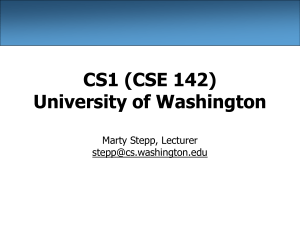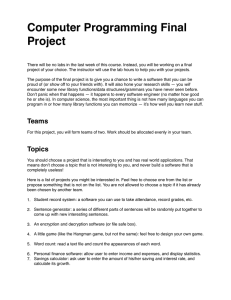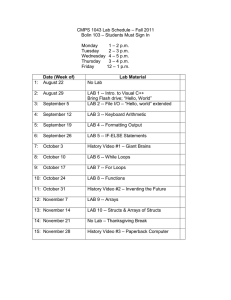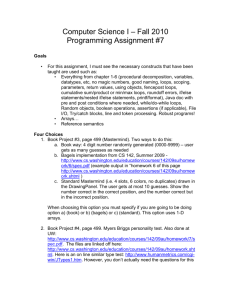CS1 (CSE 142) University of Washington
advertisement
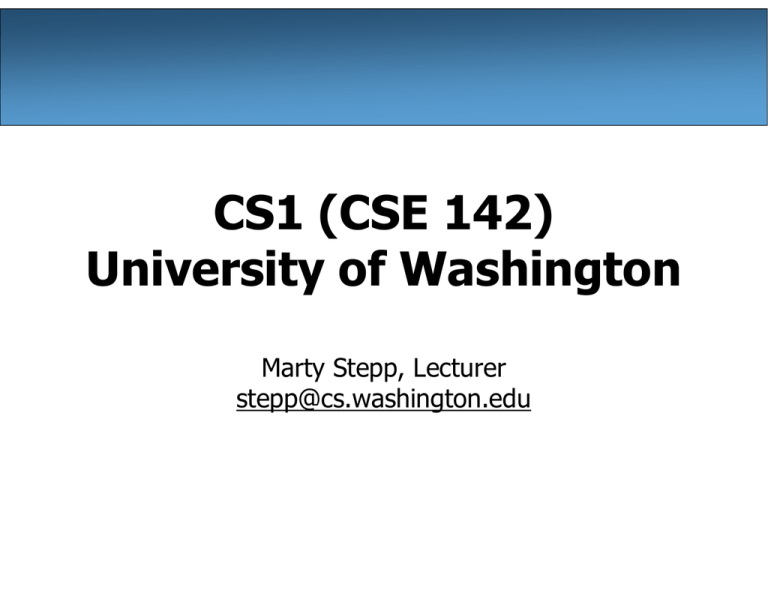
CS1 (CSE 142) University of Washington Marty Stepp, Lecturer stepp@cs.washington.edu Our CS1 course principles • Procedural – use objects early, define classes late – early focus on procedural decomposition into methods • "Back to Basics" – minimize use of scaffolding, pre-written complex code – de-emphasize fancy graphics and output – focus on algorithmic thinking and problem solving • challenging, highly structured course – assignments and exams: difficult but well-specified, predictable – strict grading scale – lots of help available (lab hours, section, book, email, msg.board) 2 Procedural? Really?? Classic procedural tasks are tough! • Selection with if/else – nesting, most closely nested rule – Are these 3 ints consecutive? What triangle do these points represent? – boolean logic: De Morgan's Law, flags, passing/returning boolean • Loops – definite vs. indefinite loops – loop invariants and logical assertions – fencepost and sentinel problems • Parameters/return – students do not understand either until after lots of practice • Arrays – shifting elements – using arrays for counting and tallying – unfilled arrays as lists; inserting and removing – arrays as parameters (references) 3 Why Java? • Why not C/C++ or Pascal? – C[++] makes too many simple things hard (strings, memory, .h files, pointers, no objects, bad type system, limited libraries) – Pascal would be fine for some tasks, but worse for OOP and is no longer an active "real world" language being used – Java gives us some nice things that the others don't (collections, I/O abstractions, good community and software support, etc.) • Why not Python, Ruby, etc.? – industry demand for Java – proliferation of resources, materials, libraries – easier transition to upper-division courses 4 Course structure • lectures – "sage on the stage" (with lots of questions) • TA discussion sections – 1 per week; 50 minutes – led by undergrad TAs – each comes with a problem set, syntax cheat sheet, solution key • closed labs – new feature for Spring 2010 – optional weekly 80-minute lab for 1 credit ("CSE 190") 5 Textbook • Building Java Programs , 2nd edition (buildingjavaprograms.com) – new chapters: implementing collections linked lists, binary trees – improved: proc. design, boolean logic, arrays, OOP, inheritance – new end-of-chapter exercises geared at our labs / TA sections • textbook as central hub of course – – – – – – – weekly written problems (due in section) tight integration between lectures and book case studies similar to weekly assignments end-of-chapter problems solved in lab/section book as reference on our open-book exams same book for CS1 and CS2 resources available on book web site 6 Grading and assessment • homework 45%, midterm 20%, final 30%, participation 5% • homework assignments as focal point of course – – – – – approximately one assignment per week; 60-100 lines of code graded 50/50 on "external" and "internal" correctness (style) detailed problem descriptions vague solution descriptions (not, "implement this interface") provide testing materials (expected outputs; unit tests) 7 Weeks 1-2 • Week 1: Basic Java, procedural programming (Ch. 1) – static methods, println – lecture programs: print repeated text figures – homework: "cumulative" song (12 days of xmas) • Week 2: Data and definite loops (Ch. 2) – expressions, variables, types, scope, constants – for loops (including nested loops) – lecture programs: print patterns of text – homework: print a patterned figure (rocket; space needle; book) 8 Weeks 3-4 • Week 3: Parameterization (Ch. 3; Supplement 3G) – 2D graphics (as killer example for parameterization) • instructor-provided DrawingPanel class – lecture programs: draw cars, pyramids, projectiles, etc. – homework: draw a patterned graphical figure or optical illusion • Week 4: Data/control flow; selection (Ch. 4) – return – if/else – interactive programs with Scanner – lecture program: compute TA salaries; body mass index – homework: SAT/ACT scores/admissions; Grades; birthdays 9 Student creativity • • • • • • • Creative song verses ASCII art contest Doodle contest Haiku poems Mad lib creation Personality test Critter Husky competition 10 Facebook application • • • • FB app created by former TA/instructor Victoria Kirst students post creative homework submissions other students and FB friends can vote on favorites an excellent advertisement for CSE 142! 11 Weeks 5-6 • Week 5: logic and indefinite loops (Ch. 5) – – – – – boolean, logical assertions while loops, random numbers fencepost and sentinel problems lecture programs: roll dice, roulette, math tutor homework: number guessing game; random walk; hangman • Week 6: midterm – exam cramming as an opportunity for learning 12 Weeks 7-8 • Week 7: File processing (Ch. 6) – Scanner, File, PrintStream – lecture programs: process IMDb data – homework: baby name graph; mad libs • Week 8: Arrays (Ch. 7) – lecture programs: midterm score tally; Benford's Law – homework: Myers-Briggs personality test; DNA; Bagels game 13 Weeks 9-10 • Week 9: Classes and objects (Ch. 8) – fields, methods, constructors, encapsulation – lecture programs: Point class; Date class – homework: Critters (2D OOP virtual world) • Week 10: Inheritance/interfaces (Ch. 9); Final exam – not tested via homework (exam only) 14 jGRASP • decreased emphasis on bulky IDEs (e.g. Eclipse, NetBeans) • jGRASP – simple, basic – runs on Win/Mac/Linux – – – – excellent debugger data structure visualizations interactions pane soon: JUnit – no auto-completion – no error underlining 15 TAs and sections • weekly meetings w/ instructor – what to teach in section – common student issues, questions • "head TA" role • TA coordinators – weekly training • "community meetings" 16 Getting help • support resources for students – lecture programs very similar to assignment • Example: Body Mass Index (BMI) program – – – – screen-cast videos and slides available for each lecture tight integration with textbook chapter and case study TA section materials directly relate to assignment Introductory Programming Lab ("IPL") staffed by TAs 17 Lab hours ("IPL") • computer lab open 6-7 days per week, ~ noon - 9pm – contrast between office hours and IPL hours • staffed by undergrad TAs to answer homework questions – TAs are given training to help understand how much help to give! • TA-written queue/help management web site • lists of common questions (FAQs) 18 Closed lab sessions • lab handouts for weekly 80-minute labs publicly available • read/understand, debug/improve, and write code • tight integration with textbook and course 19 Style guidelines • "internal correctness" (style) graded strictly, weighted heavily – 50% of homework grade – Why? • resources to students – online style guidelines, examples – detailed feedback from grader – warnings ("minus-0") 20 Grade-It • web-based software for grading homework assignments – turnin; scoresheets; annotations; scripts; publishing; data/stats analysis; consistency checks; TA management 21 Academic integrity • individual homework assignments (not pairs) • web software to check for similarity using MOSS 22 Practice-It • web-based software for practicing small Java coding problems – how it's used in our course; current features/development 23 Other tools and resources • Output comparison (diff) tool • Indentation tool • Grading gripe submission form • optional sessions – Python programming (also CS2) – CS "exploration sessions" • "CS is Cool Stuff" blog • future: Twitter, Share-It 24 Conclusion • (almost) everything we use is available online – – – – http://www.cs.washington.edu/142/ http://www.cs.washington.edu/143/ http://www.cs.washington.edu/homes/reges/ctc/ http://www.buildingjavaprograms.com/ – – – – – assignment/lab/section solutions available to instructors other past assignment specs and ideas (with solutions) available testing/grading scripts, grading criteria past exams, test bank comprehensive lecture slides and notes for CS1 and CS2 • goal: integrated course "ecosystem", course-in-a-box 25
